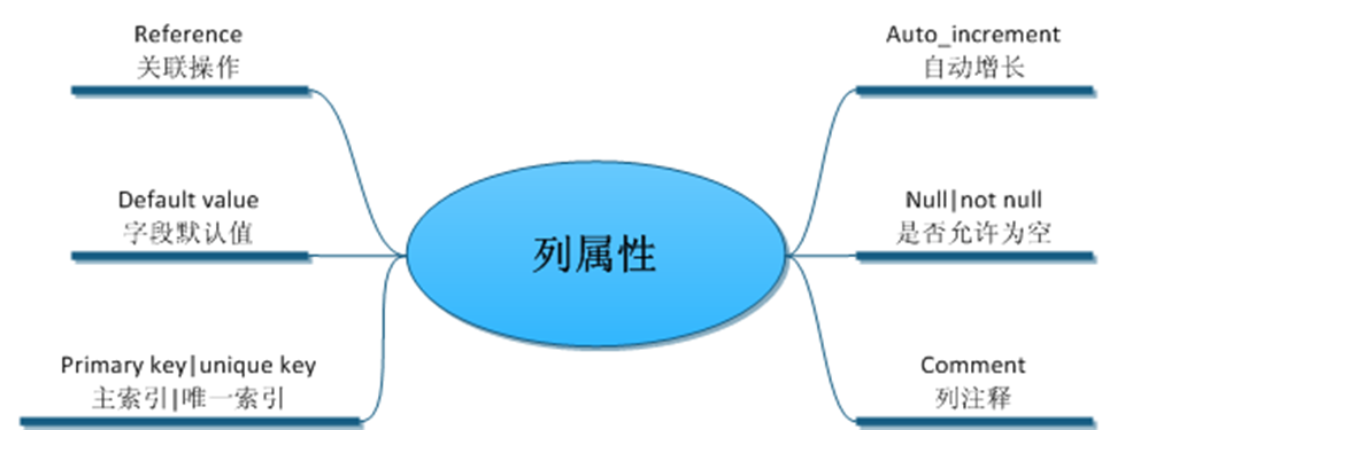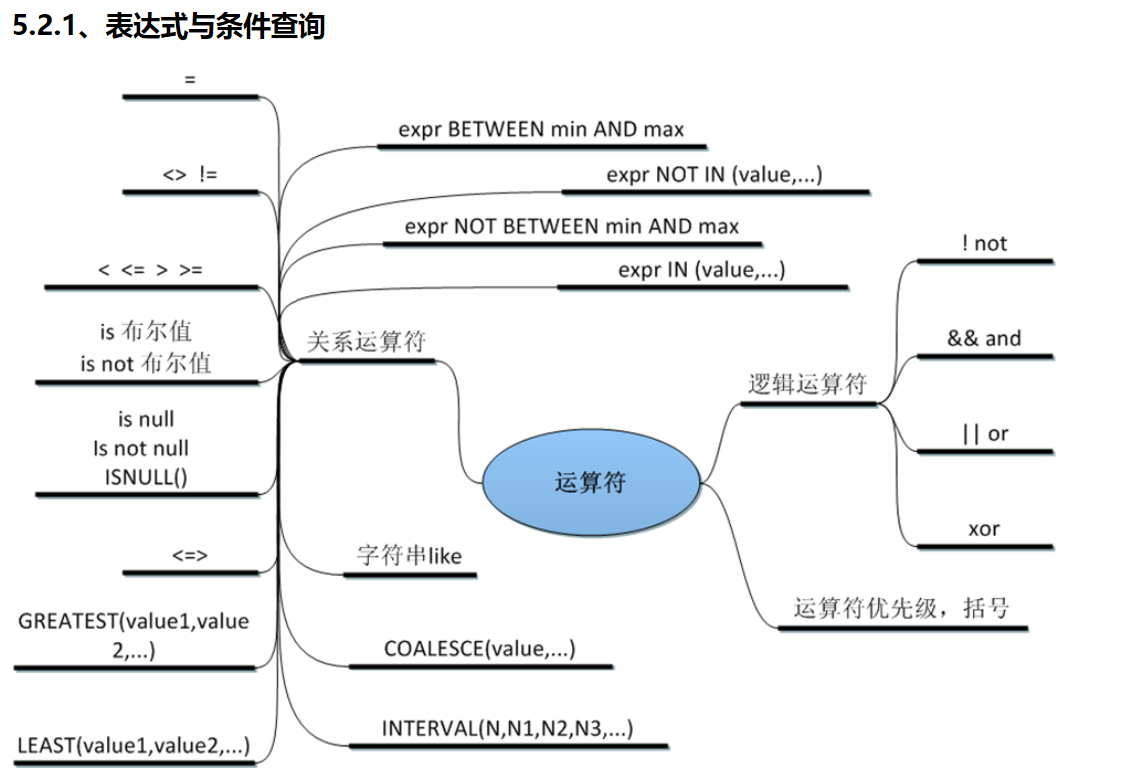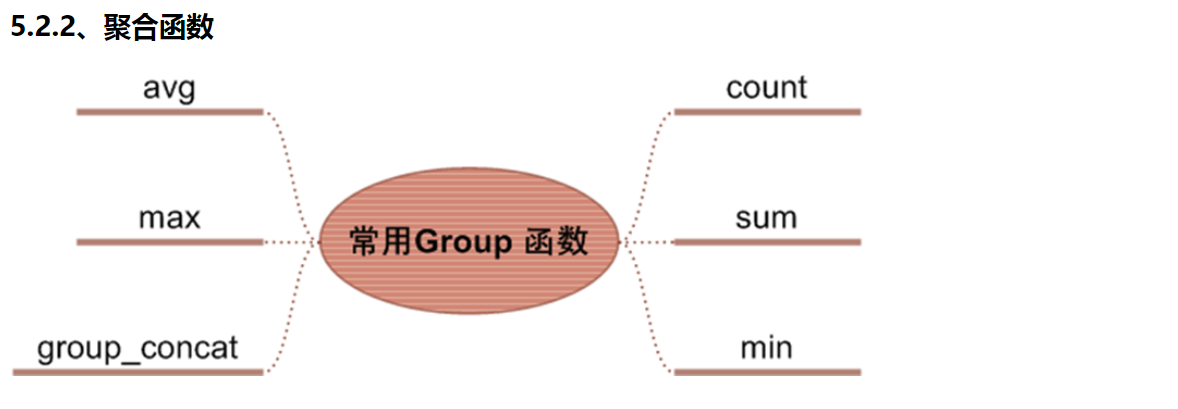
数字类型
整数: tinyint、smallint、mediumint、int、bigint
浮点数: float、double、real、decimal
日期和时间: date、time、datetime、timestamp、year
字符串类型
字符串: char、varchar
文本: tinytext、text、mediumtext、longtext
二进制(可用来存储图片、音乐等): tinyblob、blob、mediumblob、longblob
列的约束:



/* select */ ------------------
select [all|distinct] select_expr from -> where -> group by [合计函数] -> having -> order by -> limit
a. select_expr
-- 可以用 * 表示所有字段。
select * from tb;
-- 可以使用表达式(计算公式、函数调用、字段也是个表达式)
select stu, 29+25, now() from tb;
-- 可以为每个列使用别名。适用于简化列标识,避免多个列标识符重复。
- 使用 as 关键字,也可省略 as.
select stu+10 as add10 from tb;
b. from 子句
用于标识查询来源。
-- 可以为表起别名。使用as关键字。
select * from tb1 as tt, tb2 as bb;
-- from子句后,可以同时出现多个表。
-- 多个表会横向叠加到一起,而数据会形成一个笛卡尔积。
select * from tb1, tb2;
c. where 子句
-- 从from获得的数据源中进行筛选。
-- 整型1表示真,0表示假。
-- 表达式由运算符和运算数组成。
-- 运算数:变量(字段)、值、函数返回值
-- 运算符:
=, <=>, <>, !=, <=, <, >=, >, !, &&, ||,
in (not) null, (not) like, (not) in, (not) between and, is (not), and, or, not, xor
is/is not 加上ture/false/unknown,检验某个值的真假
<=>与<>功能相同,<=>可用于null比较
d. group by 子句, 分组子句
group by 字段/别名 [排序方式]
分组后会进行排序。升序:ASC,降序:DESC
以下[合计函数]需配合 group by 使用:
count 返回不同的非NULL值数目 count(*)、count(字段)
sum 求和
max 求最大值
min 求最小值
avg 求平均值
group_concat 返回带有来自一个组的连接的非NULL值的字符串结果。组内字符串连接。
e. having 子句,条件子句
与 where 功能、用法相同,执行时机不同。
where 在开始时执行检测数据,对原数据进行过滤。
having 对筛选出的结果再次进行过滤。
having 字段必须是查询出来的,where 字段必须是数据表存在的。
where 不可以使用字段的别名,having 可以。因为执行WHERE代码时,可能尚未确定列值。
where 不可以使用合计函数。一般需用合计函数才会用 having
SQL标准要求HAVING必须引用GROUP BY子句中的列或用于合计函数中的列。
f. order by 子句,排序子句
order by 排序字段/别名 排序方式 [,排序字段/别名 排序方式]...
升序:ASC,降序:DESC
支持多个字段的排序。
g. limit 子句,限制结果数量子句
仅对处理好的结果进行数量限制。将处理好的结果的看作是一个集合,按照记录出现的顺序,索引从0开始。
limit 起始位置, 获取条数
省略第一个参数,表示从索引0开始。limit 获取条数
h. distinct, all 选项
distinct 去除重复记录
默认为 all, 全部记录
--------------------------------------------------------那么好了!咋们开始练习吧-----------------------------------------------------------------------------------
class表创建语句
create table class(cid int not null auto_increment primary key, caption varchar(32) not null)engine=innodb default charset=utf8;
student表创建语句
create table student(
-> sid int not null auto_increment primary key,
-> sname varchar(32) not null,
-> gender varchar(8) not null,
-> class_id int not null)engine=innodb default charset=utf8;
teacher表创建语句
create table teacher(
-> tid int not null auto_increment primary key,
-> tname varchar(32) not null)engine=innodb default charset=utf8;
course表创建语句
create table course(
-> cid int not null auto_increment primary key,
-> cname varchar(16) not null,
-> teacher_id int not null)engine=innodb default charset=utf8;
score表创建语句
create table score(
-> sid int not null auto_increment primary key,
-> student_id int not null,
-> corse_id int not null,
-> number int not null)engine=innodb default charset=utf8;
1、自行创建测试数据 2、查询“生物”课程比“物理”课程成绩高的所有学生的学号; select A.student_id,sw,ty from (select student_id,number as sw from score left join course on score.corse_id = course.cid where course.cname = '生物') as A left join (select student_id,number as ty from score left join course on score.corse_id = course.cid where course.cname = '体育') as B on A.student_id = B.student_id where sw > if(isnull(ty),0,ty); 3、查询平均成绩大于60分的同学的学号和平均成绩; 思路: 产寻学生的id,和成绩,然后用avg函数来求得同一id号的学生平均成绩,并用having进行成绩的筛选 select student_id,avg(number) from score group by student_id having avg(number)>60; 增加显示学生名 select student_id,student.sname,avg(number) from score left join student on score.student_id=student.sid group by student_id having avg(number)>60; 第二种实现方式 个人觉得这种方式好理解一些,语法结构是 先通过select student_id,avg(number) as stu_num from score group by student_id语句分组将数据取出并起临时表别名为SCORE,然后在和student表进行连表。 select SCORE.student_id,SCORE.stu_num from (select student_id,avg(number) as stu_num from score group by student_id) as SCORE left join student on SCORE.student_id=student.sid; 4、查询所有同学的学号、姓名、选课数、总成绩; 语句进化过程: (1)先讲student表关联起来,关联条件是student_id select * from score left join student on score.student_id = student.sid; (2)再通过条件筛选自己需要显示的内容,用limit来分页显示 select score.student_id,student.sname,score.corse_id,score.number from score left join student on score.student_id = student.sid limit 5; (3)用聚合函数count来统计课程数,用sum来算成绩的合。 select score.student_id,student.sname,count(score.corse_id),sum(score.number) from score left join student on score.student_id = student.sid group by score.student_id limit 5; 终极: select score.student_id,student.sname,count(score.corse_id),sum(score.number) from score left join student on score.student_id = student.sid group by score.student_id; 5、查询姓“李”的老师的个数; select count(tname) from teacher where tname like "李%"; 6、查询没学过“叶平”老师课的同学的学号、姓名; (1)查出李平老师所受的课 select cid from course left join teacher on course.teacher_id=teacher.tid where teacher.tname="李平老师"; (2)查出选择李平老师讲课的学生 select * from score where score.corse_id in (select cid from course left join teacher on course.teacher_id=teacher.tid where teacher.tname="李平老师") (3)排除选择李平老师讲课的学生 select sid,sname from student where student.sid not in (select student_id from score where score.corse_id in (select cid from course left join teacher on course.teacher_id=teacher.tid where teacher.tname="李平老师")); 7、查询学过“001”并且也学过编号“002”课程的同学的学号、姓名; (1)取出课程id是1和2的课程 select * from score where corse_id=1 or corse_id=2; (2)通过student_id来进行分组根据having来过来选择两门的学生 select NEW_C.student_id,count(NEW_C.corse_id) as NUM from (select student_id,corse_id from score where corse_id=1 or corse_id=2) as NEW_C group by NEW_C.student_id having NUM=2; (3)连表 select A.id,student.sname from (select NEW_C.student_id as ID,count(NEW_C.corse_id) as NUM from (select student_id,corse_id from score where corse_id=1 or corse_id=2) as NEW_C group by NEW_C.student_id having NUM=2) as A left join student on A.ID=student.sid; 8、查询学过“叶平”老师所教的所有课的同学的学号、姓名; (1)连表查询课程和老师,并过滤出李平老师 select cid,cname,teacher.tname from course left join teacher on course.teacher_id=teacher.tid where teacher.tname='李平老师'; (2)查出选择李平老师课程的学生id select * from score where corse_id in (select cid from course left join teacher on course.teacher_id=teacher.tid where teacher.tname='李平老师') group by student_id; (3)关联学生表显示姓名 select A.student_id,student.sname from (select score.student_id from score where score.corse_id in (select course.cid from course left join teacher on course.teacher_id=teacher.tid where teacher.tname='李平老师') group by student_id) as A left join student on A.student_id=student.sid; 9、查询课程编号“002”的成绩比课程编号“001”课程低的所有同学的学号、姓名; select A.student_id,num_id1,num_id2 from (select student_id,number as num_id1 from score where corse_id=1) as A left join (select student_id,number as num_id2 from score where corse_id=2) as B on A.student_id = B.student_id where num_id1 > if(isnull(num_id2),0,num_id2); 10、查询有课程成绩小于60分的同学的学号、姓名; select student.sid,student.sname from (select score.student_id from score where score.number <60 group by score.student_id) as A left join student on student.sid= A.student_id; 11、查询没有学全所有课的同学的学号、姓名; select student.sid,student.sname from (select student_id,count(corse_id) as S_NUM from score group by student_id having S_NUM < (select count(cname) as C_NUM from course)) as A left join student on student.sid=A.student_id; 12、查询至少有一门课与学号为“001”的同学所学相同的同学的学号和姓名; (1)查询学生所选课程是否在学生id为1的学生的课程里面 select student_id from score where student_id !=1 and score.corse_id in(select corse_id from score where student_id = 1) group by student_id; (2)和学生表关联取出相关的ID和姓名 select student.sid,student.sname from (select student_id from score where student_id !=1 and score.corse_id in(select corse_id from score where student_id = 1) group by student_id) as A left join student on A.student_id=student.sid; 13、查询至少学过学号为“001”同学所选课程中任意一门课的其他同学学号和姓名; select student.sid,student.sname from (select student_id from score where student_id !=1 and score.corse_id in(select corse_id from score where student_id = 1) group by student_id having count(corse_id)=(select count(corse_id) from score where student_id=1)) as A left join student on A.student_id=student.sid; 14、查询和“002”号的同学学习的课程完全相同的其他同学学号和姓名; (1)和002号同学选择的个数相同的学生id select student_id,count(student_id) from score group by student_id having count(student_id) = (select count(1) as a from score where student_id=2) (2)在筛选和002好同学选择课程名相同的学生id select student_id,sname from score left join student on score.student_id = student.sid where student_id in (select student_id from score group by student_id having count(student_id) = (select count(1) as a from score where student_id=2)) and corse_id in (select corse_id from score where student_id =2) group by student_id having count(corse_id) = (select count(1) as a from score where student_id=2); 15、删除学习“叶平”老师课的SC表记录; delete from score where corse_id in (select cid from course left join teacher on course.teacher_id = teacher.tid where teacher.tname = "李平老师"); 16、向SC表中插入一些记录,这些记录要求符合以下条件:①没有上过编号“002”课程的同学学号;②插入“002”号课程的平均成绩;? select student_id,2,(select avg(number) from score where corse_id =2) as a from score where student_id not in (select student_id from score where corse_id=2) group by student_id; insert into score (student_id,corse_id,number) select student_id,2,(select avg(number) from score where corse_id =2) as a from score where student_id not in (select student_id from score where corse_id=2) group by student_id; 17、按平均成绩从低到高显示所有学生的“语文”、“数学”、“英语”三门的课程成绩,按如下形式显示: 学生ID,语文,数学,英语,有效课程数,有效平均分; 第一种实现方式 select SC.student_id,(select number from score where score.student_id = SC.student_id and corse_id = 1) as sw,(select number from score where score.student_id = SC.student_id and corse_id = 2) as wl,(select number from score where score.student_id = SC.student_id and corse_id = 3) as ty,(select number from score where score.student_id = SC.student_id and corse_id = 4) as ms,count(SC.corse_id),avg(SC.number) from score as SC group by SC.student_id order by avg(SC.number) desc; 第二种实现方式 select SC.student_id,(select number from score left join course on score.corse_id = course.cid where course.cname = "生物" and score.student_id = SC.student_id) as sw,(select number from score left join course on score.corse_id = course.cid where course.cname = "物理" and score.student_id = SC.student_id) as wl,(select number from score left join course on score.corse_id = course.cid where course.cname = "体育" and score.student_id = SC.student_id) as ty,(select number from score left join course on score.corse_id = course.cid where course.cname = "美术" and score.student_id = SC.student_id) as ms,count(SC.corse_id),avg(SC.number) from score as SC group by SC.student_id order by avg(SC.number) desc; 18、查询各科成绩最高和最低的分:以如下形式显示:课程ID,最高分,最低分; 思路:通过课程id来进行分组,这个时候会显示四行,然后用聚合函数max,min来找出最大值和最小值。 select corse_id,max(number) as max_num,min(number) as min_num from score group by corse_id; 19、按各科平均成绩从低到高和及格率的百分数从高到低顺序; 新知识点:case when then相当于if判断 select corse_id,avg(number),sum(case when score.number>60 then 1 else 0 end)/count(1)*100 as jgl from score group by corse_id; 20、课程平均分从高到低显示(现实任课老师); select A.avg_num,course.cname,teacher.tname from (select avg(number) as avg_num,corse_id from score group by corse_id) as A left join course on course.cid = A.corse_id left join teacher on teacher.tid = course.teacher_id order by A.avg_num desc; 21、查询各科成绩前三名的记录:(不考虑成绩并列情况)? select score.sid,score.corse_id,score.number,T.first_num,T.second_num from score left join (select sid,(select number from score as s2 where s2.corse_id = s1.corse_id order by number desc limit 0,1) as first_num, (select number from score as s2 where s2.corse_id = s1.corse_id order by number desc limit 3,1) as second_num from score as s1) as T on score.sid =T.sid where score.number <= T.first_num and score.number >= T.second_num; 22、查询每门课程被选修的学生数; select corse_id,count(score.student_id) from score group by score.corse_id; 23、查询出只选修了一门课程的全部学生的学号和姓名; select A.c_id,student.sname from (select count(corse_id) as c_id,student_id from score group by student_id) as A left join student on student.sid=A.student_id having A.c_id =1; 24、查询男生、女生的人数; select * from (select count(1) as M from student where gender="男") as A,(select count(1) as W from student where gender="女") as B; 25、查询姓“张”的学生名单; select sname from student where sname like "张%"; 26、查询同名同姓学生名单,并统计同名人数; select count(sname) from student group by sname; 27、查询每门课程的平均成绩,结果按平均成绩升序排列,平均成绩相同时,按课程号降序排列; select corse_id,avg(number) from score group by corse_id order by avg(number) asc,corse_id desc; 28、查询平均成绩大于85的所有学生的学号、姓名和平均成绩; select A.student_id,student.sname,A.avg_num from (select avg(number) as avg_num,student_id from score group by student_id having avg_num > 80) as A left join student on student.sid = A.student_id; 29、查询课程名称为“数学”,且分数低于60的学生姓名和分数; select A.student_id,student.sname,A.number from (select student_id,number from score where corse_id=(select cid from course where cname="生物") having number < 60) as A left join student on student.sid = A.student_id; 30、查询课程编号为003且课程成绩在80分以上的学生的学号和姓名; 第一种 select A.student_id,student.sname from (select student_id,number from score where corse_id=3 group by student_id having number > 80) as A left join student on student.sid=A.student_id; 第二种 select * from score where score.student_id = 3 and score.num > 80 31、求选了课程的学生人数 select count(A.student_id) from (select student_id from score group by student_id) as A; 32、查询选修“杨艳”老师所授课程的学生中,成绩最高的学生姓名及其成绩; select score.corse_id,student.sname,score.number from score left join student on score.student_id=student.sid where score.corse_id in (select course.cid from course left join teacher on course.teacher_id=teacher.tid where tname = "刘海燕老师") order by score.number desc limit 3; 33、查询各个课程及相应的选修人数; 第一种 select A.c_num,course.cname from (select count(student_id) as c_num,corse_id from score where corse_id in (select cid from course) group by corse_id) as A left join course on course.cid =A.corse_id ; 第二种 select course.cname,count(1) from score left join course on score.corse_id = course.cid group by corse_id; 34、查询不同课程但成绩相同的学生的学号、课程号、学生成绩; select DISTINCT s1.corse_id,s2.corse_id,s1.number,s2.number from score as s1, score as s2 where s1.number = s2.number and s1.corse_id != s2.corse_id; 35、查询每门课程成绩最好的前两名; select score.sid,score.corse_id,score.number,T.first_num,T.second_num from score left join (select sid,(select number from score as s2 where s2.corse_id=s1.corse_id order by number desc limit 0,1)as first_num, (select number from score as s2 where s2.corse_id=s1.corse_id order by number desc limit 1,1) as second_num from score as s1) as T on score.sid = T.sid where score.number <= T.first_num and score.number >= T.second_num; 36、检索至少选修两门课程的学生学号; select student_id,count(corse_id) from score group by student_id having count(corse_id)>1 37、查询全部学生都选修的课程的课程号和课程名; select count(student_id) from score group by corse_id having count(student_id) = (select count(sid) from student); 38、查询没学过“叶平”老师讲授的任一门课程的学生姓名; 第一种 select sname from(select A.student_id as n_s_id from (select student_id,corse_id from score) as A left join course on course.cid=A.corse_id where course.teacher_id not in (select tid from teacher where tname="李平老师") group by A.student_id ) as B left join student on student.sid=B.n_s_id; 第二种 select student_id,student.sname from score left join student on score.student_id = student.sid where score.corse_id not in (select cid from course left join teacher on course.teacher_id = teacher.tid where tname = "李平老师") group by student_id; 39、查询两门以上不及格课程的同学的学号及其平均成绩; select avg(number) from score where student_id in (select student_id from score where number < 60 group by student_id having count(corse_id) >1); 40、检索“004”课程分数小于60,按分数降序排列的同学学号; select A.number,student.sname,student.sid from (select score.number,score.student_id from score where score.corse_id = 4 and score.number<60) as A left join student on student.sid = A.student_id order by A.number desc; 41、删除“002”同学的“001”课程的成绩; delete from score where corse_id = 1 and student_id = 2
ready ?